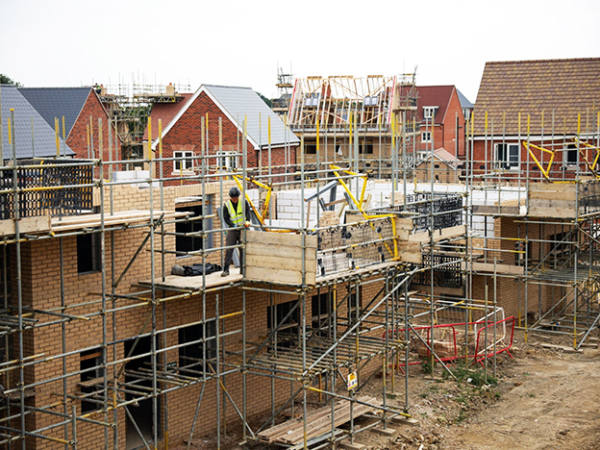Predicting movements in house prices is always something of a fool’s errand. At the end of 2019, house price inflation was low (actually pushing towards zero) and trends were pretty flat. There were few additional levers left to pull for the housing market: interest rates already rock bottom, loans to value (LTV) rising, income multiples high and population pressures receding thanks to Brexit, so things looked set to stay that way.
Roll forward 12 months, and Covid’s ‘escape to the country’ along with the woefully ill-advised (and unnecessarily extended) stamp-duty ‘holiday’ meant annual house price inflation had raced to 7.5 per cent. Six months later it was running at 13.5 per cent. Since January 2020 the price of the average UK home (according to Nationwide) has increased by £55,000 or 26 per cent: this is more than they had increased in the preceding 9 years. Few, if any, saw that coming.
House prices are a near obsession. Those who are already owners celebrate the rise in personal wealth and those outside ownership bemoan that they will never get the opportunity to own. In the minds of politicians, the direction of house prices can win or lose power. So, whether it is right or wrong to obsess about house prices, the question that is on a lot of lips, a lot of the time: where are house prices going next? We appear to be at a point of inflexion, so however ill-advised it is to speculate we examine what we see as the key issues that might settle this question. There are a significant number of different drivers of the housing market but in this article I have picked what I believe to be the most important at this juncture: essentially can a borrower borrow and can/will a lender lend? While many view the housing market as being one driven by aspirations, in reality it is all about cost and availability of debt.
Blowing off the froth
If nothing else house prices are likely going to need to reset after the short-term pressures that generated sizable amounts of froth. The likes of sealed bids and gazumping (outbidding the original buyer) typically cause prices to swell above where they might naturally sit. The elimination of actions such as these (gazumping is reported to have been replaced by ‘gazundering’ where the buyer demands a lower price right before exchange of contracts, threatening to withdraw) is often the first move downwards, and this tidal pull back-back can involve sizable moves. Any such changes are likely only to be the overture.
Affordability drives everything
House prices can only continue to rise as long as those buying, or aiming to buy, can fund the repayments on a mortgage. A constant cry in the housing market has been that potential buyers feel obstructed as they could afford the monthly mortgage payments and that it is only raising the deposit that holds them back. Many renters have argued that they paid more in rent than it would cost to service a mortgage. This, however, may no longer be the case with interest rates rising rapidly.
A key measure of the housing market’s health is how much of a buyer’s take home pay is consumed by mortgage payments. The rule of thumb is that if payments are one-third or less of disposable income, then there is little concern. In Q4 of 2019 just before the pandemic, the average spending by first time buyers (who are now around half the market and the foundation of other transactions higher up the chain) on a mortgage across the UK was 27.3 per cent of disposable income: all good, ish. Roll forward to Q2 of 2022 and this had already climbed to 32 per cent and using today’s mortgage rates that figure could rise to nearer 45 per cent. This is well above both what is seen as affordable, and, perhaps more disturbing, is the same level as we saw back in late 2007 just as the global financial crisis (GFC) kicked off.
First time buyers mortgage vs take-home pay
Source: Nationwide
But this just factors in the increase in mortgage payments and does not account for general inflationary pressures and rising energy costs. If mortgage rates rise another 50 basis point by year end, if the energy price cap flows through to consumers without intervention, and the CPI+3.7 per cent escalators on many service contracts (eg mobile phones, TV and other streaming services) are enacted, this figure would likely rise above 50 per cent. The market has never reached these levels (in the last 40 years at least) and not buckled.
One chart to rule them all
There is one analytical graph that helps explain (to me at least) why the housing market maintained its head of steam over the last decade, despite steady and often steeply rising prices. This chart (below) plots how much a monthly mortgage payment would be at the average mortgage rate (75 per cent LTV, 5 year fixed rate as recorded by the Bank of England) on the average UK house price (as recorded by Nationwide) on a 30 year repayment mortgage basis. Essentially from 2011 to 2020/21 the monthly mortgage repayment barely changed in nominal terms and fell in real terms (wage inflation adjusted). So, even as prices rose, this did not impinge upon peoples’ ability to buy and the housing market actually became more affordable.
But that has sharply changed. As the latest months in these charts show, a mortgage has very rapidly become more expensive than at any time in the last 10 years due to the price surge and higher mortgage rates. Here we only used the latest, historic average mortgage rate of 3.45 per cent from July’s data – rates are now over 4 per cent and risk rising further.
The cost of funding the ‘average’ mortgage – cash basis (£)
Sources: BankStats, Nationwide, Investors’ Chronicle
The low cost of buying a home that has been a constant feature for the last 10 or more years looks to be over. The trend in our second chart suggests that a ‘bearable’ or sustainable monthly cost that would keep prices on a rising trend would be around £800-£825 per month. If we reverse engineer that figure using current mortgage interest rates, this level of monthly repayment would only service an average house price of £171,000: that is around £100,000 lower than the current average. That is not to suggest that house prices will fall by anything like that extent, but does indicate that it is going to be very difficult to support today’s house prices.
While sizable house price falls might appear likely on paper, the reality is more likely to be lesser falls but sizable falls in activity level, initially at least: many sellers will simply not accept (or be able to accept) substantial drops in value and will instead withdraw from the market. Any such choking off of supply would buoy up prices temporarily but estate agents (who are effectively the UK’s house pricing mechanism) will always try to kickstart the market by lowering prices - they need activity to earn their fees and are much indifferent to price levels. Add in the already visible trend of lenders ‘down-valuing’ against agreed selling prices and the downwards pressure on prices feels irresistible.
The cost of funding the ‘average’ mortgage – wage inflation adjusted
Sources: BankStats, Nationwide, Investors’ Chronicle
Energy cap rise effect
What impact could the latest rise in the energy cap have if left unaddressed by government intervention? The new cap is, on average £131.50 per month higher from October: for most homeowners with mortgages the increase is likely to be higher than this, but here we will look at the impact just from the average change. At today’s mortgage interest rates (around 4 per cent) an extra £131.50 of outgoings at constant incomes, the same affordability assessment by the lender and unchanged loan-to-income ratios could reduce the amount that can be borrowed by £27,500. The average house price in the UK according to Nationwide is £271,209 so lowering buyers’ mortgage capacity by this amount could have a material effect on what buyers are willing and able to pay. Tax cuts, emergency energy payments and wage increases may offset some of this but another two price cap rises are expected to impact in January and April 2023. House buyers’ spending power is dropping and that has to be a further drag on house prices.
Lenders’ risk appetite
After a surge in the housing market, mortgage lenders are in a curious position. The surge in prices in the last two years mean that the LTV across their whole mortgage lending book has improved and overall risk has, technically, reduced. Despite this, lenders are likely to be more wary about future lending due to poorer borrower affordability. This means that while a systemic financial crisis as we had in 2007 is unlikely to be repeated, banks’ appetite for high ratio lending (income and LTVs) is likely to be reduced. If house prices fall, that desire to lend is likely to recede further and lenders’ balance sheets will weaken. Without a strong flow of new mortgage lending, pressure on house prices is likely to increase.
While it is widely acknowledged that mortgage lending in recent times has been less reckless than in the run up to the financial crisis in 2007, mortgage lenders have been using levers and mechanisms to make mortgages more affordable (over and above falling interest rates). The main mechanism has been longer maturity mortgages with 30 to 35 year terms now the most common versus the historic norm of 25 years. Many first-time buyers now take out 40 year loans and, after long deliberation by No.10, new mortgage lender Perenna was recently licenced to offer 50 year loans. Higher LTV loans are more common than 10 years ago although 95 per cent loans remain rare (despite a government underwriting scheme for lenders) and 100+ per cent loans are non-existent. In the current climate it feels unlikely that lenders will be looking to boost buyers’ spending power using these mechanisms.
Conclusions
The conclusions here really write themselves. After two years of pricing excess and rising mortgage rates the era of fast rising prices looks to be over and it is highly likely that prices will fall in the next 18 months. As we said at the opening, trying to guess the precise timing and scale of house price movements is sheer folly and I have no intention of trying to make a precise call, other than to state my belief that prices by the end of 2023 are almost certainly going to be below those of today, perhaps materially so. But government action on cost-of-living, aggressive action on energy prices and direct intervention in the housing and/or mortgage markets are possible and would have the scope to swing the market.
However, headroom today for doing all of these is limited and housing feels more likely to be the one left out in the cold. Furthermore there are numerous additional negatives that we did not have the space to consider here: the potential drying up of intergenerational wealth transfer (‘bank of mum & dad’), recession, rising unemployment, ‘amateur’ landlords exiting the buy-to-let market, the drawn out impact of rising mortgage rates due to the staggered ending of borrowers’ fixed rate periods, that many owners are actively considering a downsizing or relocating to shore up their finances and even the scope for negative equity to return.
In our next article we will look at how a changing market is likely to impact the most readily available way for investors to align with the housing market – the UK-listed house builders.













